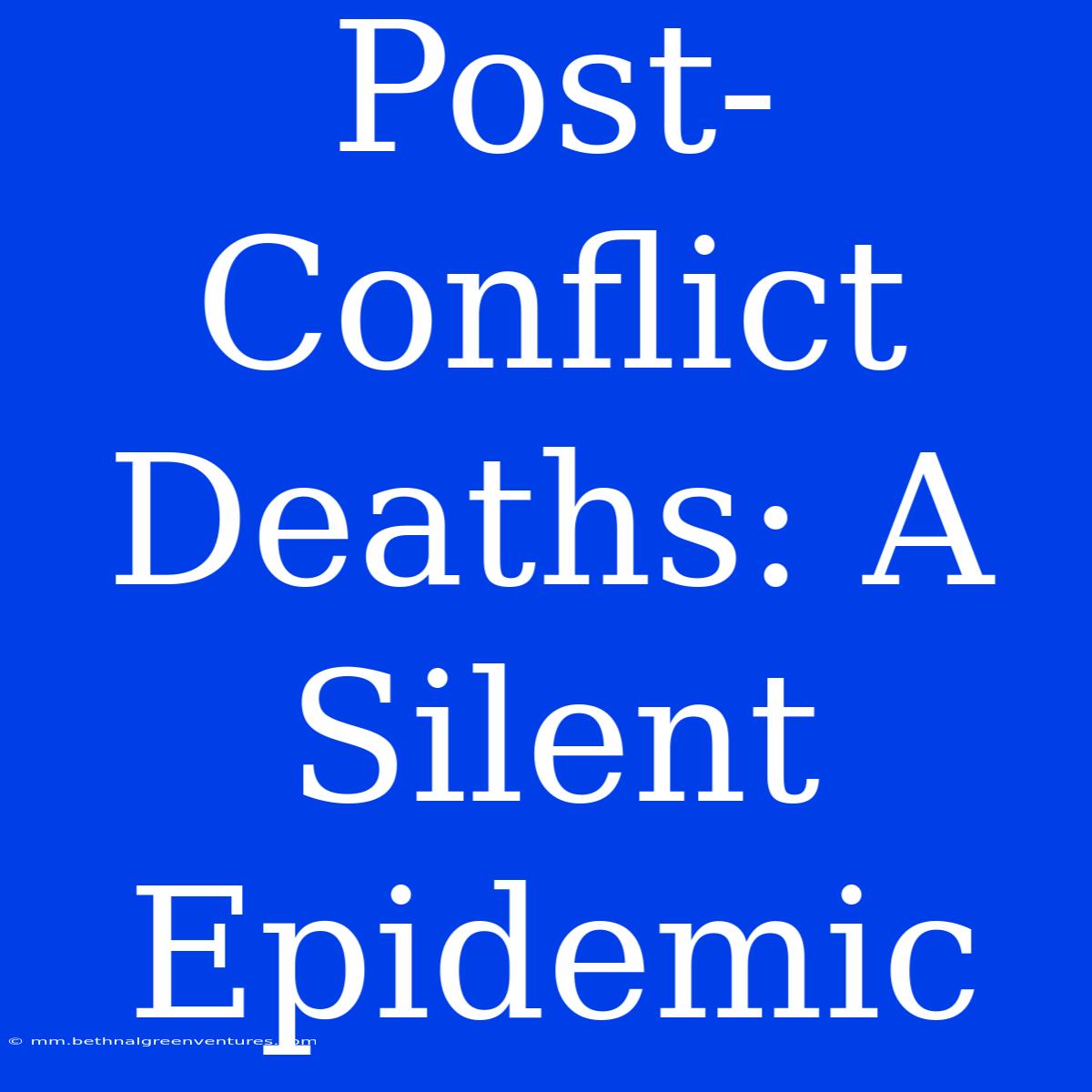Post-Conflict Deaths: A Silent Epidemic
What are post-conflict deaths, and why are they a silent epidemic? Post-conflict deaths refer to fatalities that occur after the cessation of active hostilities in a conflict. These deaths are often overlooked and underreported, making them a silent epidemic.
Editor Note: The alarming rise of post-conflict deaths calls for urgent attention and action.
These deaths are significant because they highlight the long-lasting repercussions of armed conflict. While peace agreements may be signed, the suffering continues in the form of preventable deaths stemming from:
- Lack of access to healthcare: Years of conflict often decimate healthcare systems, leading to shortages of medical professionals, equipment, and essential medications.
- Disease outbreaks: The disruption of basic sanitation and hygiene practices during conflict can lead to the spread of infectious diseases, often with deadly consequences.
- Mental health issues: Post-traumatic stress disorder (PTSD), anxiety, and depression are common among survivors of conflict, leading to increased suicide rates and other health complications.
- Violence and insecurity: Even after conflict ends, the threat of violence and insecurity can persist, contributing to deaths from accidents, injuries, and homicide.
- Malnutrition and famine: Conflict often disrupts agricultural production and supply chains, leading to widespread hunger and malnutrition, further increasing vulnerability to diseases and death.
Analysis: This in-depth analysis explores the complexities of post-conflict deaths, drawing upon data from various international organizations and research studies. We delve into the contributing factors, consequences, and potential solutions to address this critical issue.
Key Aspects of Post-Conflict Deaths:
| Aspect | Description |
|---|---|
| Prevalence: | The alarming frequency of post-conflict deaths across different regions and timeframes. |
| Causality: | Identifying the key factors responsible for the high mortality rates in post-conflict settings. |
| Impact on development: | The long-term consequences of post-conflict deaths on economic growth, social stability, and human well-being. |
| Addressing the crisis: | Analyzing various interventions and strategies aimed at reducing post-conflict deaths and promoting long-term recovery. |
Prevalence of Post-Conflict Deaths
The prevalence of post-conflict deaths is difficult to quantify accurately due to underreporting and data limitations. However, available estimates suggest that the number is substantial. The International Committee of the Red Cross (ICRC) has estimated that 90% of civilian casualties in armed conflict occur after the cessation of hostilities. This underscores the need for robust post-conflict peacebuilding efforts.
Causality of Post-Conflict Deaths
The factors contributing to post-conflict deaths are complex and multifaceted. As mentioned earlier, they include:
- Healthcare system collapse: Destruction of medical infrastructure and displacement of medical personnel during conflict leaves populations vulnerable to preventable diseases and injuries.
- Spread of infectious diseases: The disruption of sanitation and hygiene practices creates ideal conditions for disease outbreaks, leading to increased mortality rates, especially among children and the elderly.
- Mental health consequences: The trauma of conflict can lead to severe mental health issues, increasing the risk of suicide and other health complications.
- Violence and insecurity: Continuing violence, even after a peace agreement, can lead to accidents, injuries, and homicides.
Impact on Development
Post-conflict deaths have a profound impact on a country's development trajectory. The loss of life, especially among skilled professionals and young people, hampers economic growth, social progress, and the overall well-being of societies. It also places an immense strain on already fragile resources.
Addressing the Crisis
Addressing the crisis of post-conflict deaths requires a comprehensive approach that encompasses:
- Strengthening healthcare systems: Prioritizing the reconstruction and rehabilitation of healthcare infrastructure, training medical personnel, and providing essential medical supplies.
- Promoting peace and security: Addressing the root causes of conflict, fostering reconciliation, and establishing effective mechanisms for conflict resolution.
- Supporting mental health services: Providing access to mental health services for survivors of conflict, including counseling, therapy, and support groups.
- Promoting economic recovery: Investing in infrastructure, agriculture, and education to rebuild livelihoods and create sustainable opportunities.
FAQ
Q1: Why are post-conflict deaths so prevalent?
A1: Post-conflict deaths are prevalent due to the lasting impact of conflict on healthcare systems, infrastructure, and social stability.
Q2: How do post-conflict deaths impact development?
A2: Post-conflict deaths hinder economic growth, social progress, and human well-being. They also strain limited resources and hinder the reconstruction process.
Q3: What can be done to reduce post-conflict deaths?
A3: Reducing post-conflict deaths requires a comprehensive approach that includes strengthening healthcare systems, promoting peace and security, supporting mental health services, and investing in economic recovery.
Q4: Are there any international organizations working on post-conflict deaths?
A4: Yes, various organizations like the World Health Organization (WHO), the United Nations Children's Fund (UNICEF), and the ICRC are dedicated to addressing the issue of post-conflict deaths.
Q5: What role can individuals play in addressing this issue?
A5: Individuals can raise awareness about post-conflict deaths, support humanitarian organizations, and advocate for policies that prioritize peacebuilding and humanitarian aid.
Tips to Address Post-Conflict Deaths
- Donate to humanitarian organizations: Support organizations working to provide healthcare, education, and other essential services in post-conflict settings.
- Advocate for peacebuilding initiatives: Encourage your government to prioritize peacebuilding and conflict resolution in its foreign policy.
- Support initiatives that address mental health: Raise awareness about the mental health needs of conflict survivors and advocate for increased funding for mental health services.
- Educate others: Share information about post-conflict deaths and its impact on vulnerable communities.
Conclusion
Post-conflict deaths are a silent epidemic, but they should not be ignored. Addressing this issue requires a collective effort from governments, international organizations, and individuals. By prioritizing peacebuilding, humanitarian aid, and long-term development, we can work towards mitigating the devastating consequences of conflict and creating a more peaceful and prosperous future for all.
